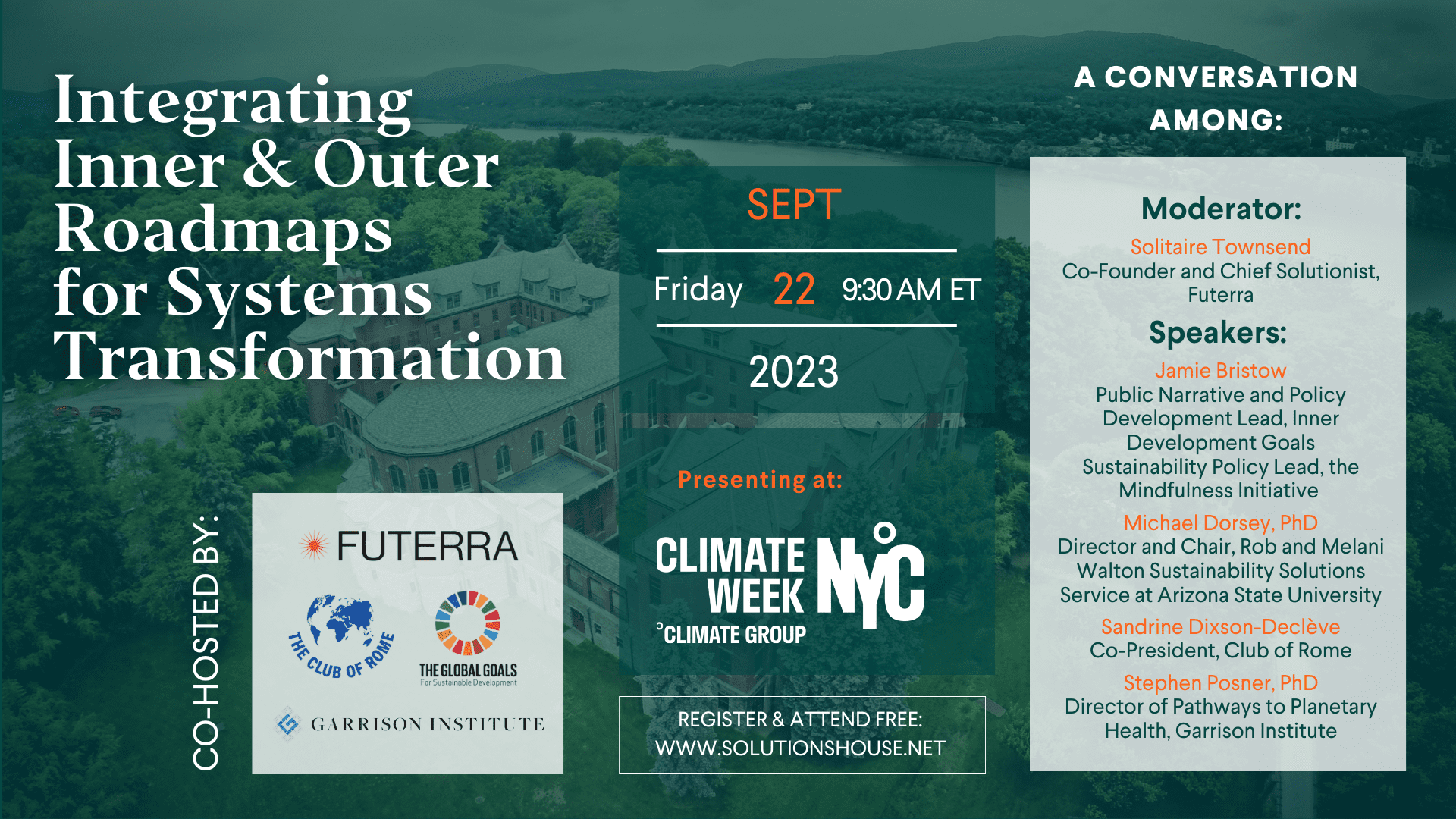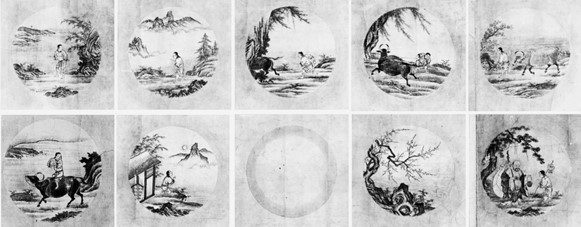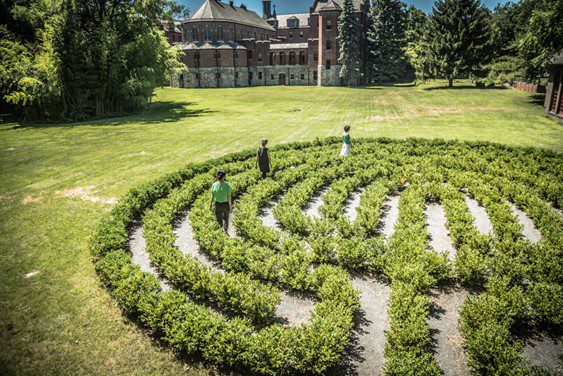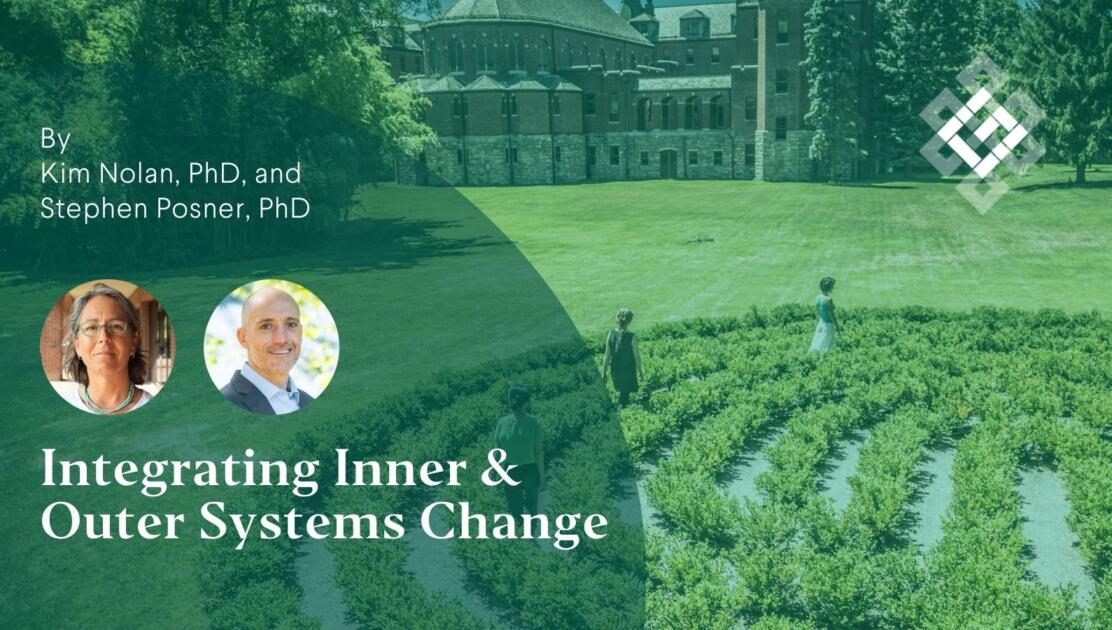Integrating Inner & Outer Systems Change
By Stephen Posner and Kim Nolan
“Yesterday I was clever, so I wanted to change the world. Today I am wise, so I am changing myself.”
—Attributed to Rumi
We cannot solve complex sustainability issues using the approaches we’ve employed in the past. We need different approaches – and different mindsets – than those we’ve drawn on thus far.
These approaches and mindsets emerge from looking inward at the same time as we make outer change – from reflecting deeply and looking with clear eyes at the entirety of what’s here now as we grapple with complex and persistent predicaments like climate change and nature loss, social justice, trauma, and exploitative economic systems. Some wisdom traditions refer to this as cultivating an inner skill set that enables one to meet the emergent needs of the present moment.
This was the focus of a Climate Week NYC panel organized by Pathways to Planetary Health on Integrating Inner and Outer Roadmaps for System Transformation.

Integrating inner and outer work is also woven into innovative centers of education and practice in organizational change, such as the Sustainable Innovation MBA Program at University of Vermont and the Center for Systems Awareness at MIT.
The roots of the word “integrate” mean “to make whole.” As planetary change rapidly unfolds – and in many cases the pace of change speeds up – we can draw wisdom and perspective from considering the wholeness of our human experiences.
To better understand why this integration matters, we can examine what happens when we don’t integrate inner and outer work.
What Happens When We Don’t Integrate, Part I: Trouble with Focusing Only on Outer Change
“Actions should be based on the foundation of being . . . our actions become a true expression of our love, caring, and awakening.”
—Thich Nhat Hanh, in Zen and the Art of Saving the Planet
When we focus only on outer change, we compartmentalize our inner experiences and neglect tending to what’s happening inside of us. This is widespread today.
Many people are well-trained to solve problems, fix issues, and master transactional relationships – all exterior-pointed actions. Without balancing our outward-facing thoughts, speech, and actions with an inward turn, we perpetuate further imbalances.
Solutions driven by the head can become disconnected from inner experiences like staying grounded, focused, and curious. In a practical sense, being disconnected from interior aspects of experience can lessen our capacity for self-awareness. What does this mean? It means we may not notice a low-grade frustration before, during, or after speaking with someone. Perhaps we don’t sense our activated anxiety while working through a project with our team. Perhaps we are so focused on our plan that we cannot hear alternative options.
None of these ways of being are very conducive to creative solutions, collaboration, or the type of communication that is urgently needed during these unprecedented times. When emotional taproots are left unaddressed, we risk living in reactive and habitual patterns of thought and behavior. Our outward actions will reflect interior conditions.
A solely outer focus can obscure our view of deeper root causes and conditions for the issues we face. We can become diverted by jumping toward ideas for global economic and policy transformation (outer change) without pausing to notice how to live in responsible relationship within local communities and ecosystems.
Credibility deteriorates when we don’t “walk the talk” or live in accordance with the outer changes we claim are needed. In addition, when we overemphasize external change we risk creating a semblance of outer progress on sustainability goals, while below the surface, deeply unsustainable patterns and outmoded values and mindsets that fuel them can continue.
Before taking an inward turn and focusing on the inner life, it is important to pause and remember the realities of privilege that exist when engaging in creating change. For now, this is simply an invitation to widen the aperture on reflection rather than an argument for dismantling systems or power structures.
What Happens When We Don’t Integrate, Part II: Trouble with Focusing Only on Our Inner Worlds
When we focus only on our inner worlds, with little or no connection to outer action, we risk remaining seated on a cushion on the sidelines.
A thousand-year-old pictorial series depicts this potential shadow. In the Zen tradition it is referenced as the 10 ox-herding pictures. You may be familiar with picture 8, the calligraphy circle called an Enso. This picture demonstrates how a meditator has cultivated skills of quieting the mind, regulating emotional flows, and not grasping onto every thought that floats across the marquee of one’s mind. Sounds lovely. Picture 9 is the esoteric empty page, articulating some semblance of oneness or awakening from all the inward focus. Again, lovely.
But it is picture 10 where the rubber hits the road. The person who has spent time contemplating, reflecting and becoming familiar with the inner landscape of their life, takes responsibility and becomes socially engaged. They leave the pristine mountain top and head directly to the marketplace to infuse wisdom and compassion into their efforts of change and transformation. That is the kind of balance we can aspire to. What do we do when we aren’t quite at the level of the Laughing Buddha, as is named the one who enters the marketplace?

Developing inner capacities like courage, agency, and the capacity to cooperate is important, but it’s not sufficient on its own for realizing planetary health and balance. We need to apply these capacities to opportunities for action. Coupling inner and outer change is a powerful pathway for linking what we know about ourselves and our planetary predicaments with what we do to address complex challenges.
What Happens When We Integrate: The Value of Inner >><< Outer
There are bodies of scientific and medical evidence showing that inner contemplative practice improves individual and collective well-being, for example in terms of cognitive skills like learning and memory, emotional regulation, and seeing different perspectives. This provides a sound foundation for action.
Integrating inner contemplative practice with outer change-making is also a way to be the change we’d like to see in the world. When we look inward, we can become more aware of interconnectedness and see our own reflections in each other, increasing capacity for collaboration.
Renowned leadership scholar Meg Wheatley reminds us that complex, self-organizing systems are inherently interwoven with their environment. In her seminal work Leadership and the New Science (1994), she describes how all structures/relationships “have a unique identity, a clear boundary, and are merged with their environment” (p.18). This kind of interconnectedness, in which a unique element holds a clear yet permeable boundary, may seem paradoxical at first glance but is actually a map toward greater balance and integration.
Contemplative practice that transforms our sense of self can lead to more cooperative and compassionate action. We can feel less isolated and build relationships among islands of coherence.
By cultivating inner resources, we can maintain connectedness and poise while grappling with great big existential issues like climate collapse. This enables us to stay oriented toward compassionate action while confronting difficult realities. For instance, climate anxiety often surfaces when we’re faced with the grief that ecological imbalance and biodiversity loss may result from our very modes of existence. With inner resilience we can address the emotional and spiritual impacts of experiencing intense struggles, while choosing to not turn away.

When we realize that everything we experience can be considered as data, we can appreciate the value of integrating inner and outer, and we can draw wisdom from the entirety of information gathered from all of human experience – from head, heart, spirit, and body. Reflecting and looking deeply enables us to see underlying causes and conditions. It invites us to tend to emotional undercurrents for urges that appear everywhere, for example urges to accelerate, grow, solve, rush, perceive crisis, and be excessively busy. In these ways, integrating inner and outer experience enhances our capacity to exercise discernment in our actions.
Integrating Old School and New School
In many ways, integrating inner and outer work is about remembering worldwide ancestral ways of knowing that emphasize the importance of inner and outer.
Eastern traditions have long-understood the essence of harmony flowing from balanced, non-dual views on experience. Stoicism describes the importance of perceiving inner reality and acting outwardly for the common good while expressing gratitude for the whole of what life offers in the present moment. A Norse myth about the deity Odin recounts that he sacrificed one of his eyes to acquire all-seeing wisdom, but there is another interpretation of Odin’s story: his omniscience derived from having one eye looking outward, and the other eye turned inward.
Many Indigenous traditions remind us how looking inward and looking outward can bring us to the same place, and that boundaries between inside and outside are relative and perhaps better described as porous membranes. These wisdom traditions remind us to keep the whole picture in view. While reductionism and compartmentalization can be powerful analytical tools, they can distort our understanding of the whole. Reintegrating inner and outer enables more effective approaches to addressing complex sustainability issues and finding balance in the apparent instability of life.
At the Garrison Institute, we apply science and contemplative practice to pressing challenges like planetary health, for example in a 2023 symposium focused on the Commons and the Common Good. Many other centers of thought and action exist, including:
- The Conscious Food Systems Alliance, a group convened by the UN “to support people from across food and agriculture systems to cultivate the inner capacities that activate systemic change and regeneration.”
- Plum Village, home of an online course on Zen and the Art of Saving the Planet and an insightful podcast, The Way Out Is In.
- Inner Green Deal, with a well-developed approach to addressing the human dimension of sustainability in a variety of settings, including with policymakers.
The work emerging from these hopeful examples demonstrates the promise of contemplative practice to grow capacity to listen deeply, be empathetic and collaborative, transform mindsets, and engage with the realm of action.
Stephen Posner, Ph.D. is the Director of Pathways to Planetary Health with the Garrison Institute. He applies scientific inquiry with contemplative practice across traditions to build a more compassionate and resilient world. His work aims to realign systems with nature – internal systems of care and thought, and outer systems like economies and ecosystems.
Kim Nolan, Ph.D. is the Graduate Programs Director with the Grossman School of Business at the University of Vermont. She is also an ordained Buddhist chaplain, an appointed member of the Vermont Commission on Women, and a lifelong advocate for social justice and human rights. Kim holds a Ph.D. in Leadership and Change from Antioch University and a M.Ed. in Counseling Psychology from Boston University .
